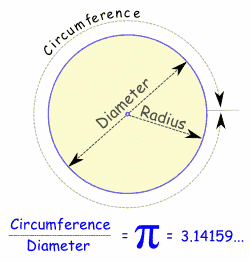
Image Source: http://upload.wikimedia.org
Drums are one of the most marvelous use of circles that we’ve ever heard of here at Passy World. So let’s get right into the beat of the Circle with a catchy Circles Song from Learning Upgrade website.
[youtube=http://www.youtube.com/watch?v=eiHWHT_8WrE&w=540&h=433]
Here is another great circles tune, this time by Maths Teacher extraordinaire: Mr Dave Johnson:
[youtube=http://www.youtube.com/watch?v=fogehnFNDw0&w=540&h=433]
So let’s start taking a deeper look into the mathematics of circles. We shall start with the distance around a circle. This is the circle’s “Perimeter”, and is given the special name of “Circumference”.

Image Source: http://files.abovetopsecret.com
Here is a video all about the Circumference of any Circle:
[youtube=http://www.youtube.com/watch?v=1XFkAZW-rWg&w=540&h=433]
Circumference Formula
The Formula for finding the circumference “C” is:
C = Pi x Diameter or C = 2 x Pi x Radius
We choose which formula to use depending on whether the math question supplies us with Diameter, or with Radius.
Diameter is the distance all the way across a circle.
Radius is the distance from the center to the edge of a circle.
Radius = 1/2 of the Diameter.
Here is a video about how we can work backwards from the Circumference, to find out the radius of the circle:
[youtube=http://www.youtube.com/watch?v=1-D_z9GatbU&w=540&h=433]
The Value of Pi
A really important part of working on Circles and spheres is the value of Pi.
Image Source: http://timthefoolman.files.wordpress.com
Pi is a mathematical constant whose value is the ratio of any circle’s circumference to its diameter.
Pi = c divided by d.
The most common value used for Pi is 3.14 or 22/7.
How the Pi Number is Determined
An estimation of Pi can be determined by drawing several circles of different sizes, and then measuring their circumferences by running a piece of string around the edge of each circle. We also need to use a ruler to measure the diameter of each circle.
For each circle, we then calculate Circumference divided by Diameter.
Here is a 3 minute YouTube video where Pi is accurately calculated using real pies.
The exact value of Pi is best calculated using a computer program, and it has lots of decimals in the answer, that extend endlessly into the billions.
For example Pi rounded off to fifty decimal places is :
3.14159265358979323846264338327950288419716939937510
To read about the fascinating history of Pi, click the link below:
http://ualr.edu/lasmoller/pi.html
Reciting of Pi
Various people reciting Pi as fast as they can on You Tube take their own world records very seriously. The one to beat is how long to recite the first 100 digits of the never ending decimals PI value.
A guy called Matt Parker originally set a World Record for reciting the first 100 digits. Then Michael J Lavery beat Matt’s record, and pegged the time back to 25 seconds:
[youtube=http://www.youtube.com/watch?v=vtBjxySCca8&w=540&h=325]
But Matt in true competitive spirit regained his world record back again with a much improved effort of just under 14 seconds. Unfortunately the YouTube video for this no longer exists.
The fastest Pi recital time, that Passy World has managed to locate on YouTube at the moment is by Rich Welling fom New York with a time of 13.89 seconds.
[youtube http://www.youtube.com/watch?v=K2hJNfXhhPw&w=540&h=435]
Finally, a very interesting video about a contender for the supreme Pi record of reciting it from memory to thousands and thousands of decimal places !
[youtube=http://www.youtube.com/watch?v=nsVyknWU7ak&w=540&h=433]
Circumference Games
Try this fun basketball game. The Coach will give you a lesson all about Circumference, that you can skip past, and then when you get questions correct, you get basketball shots. Note that to enter your player name, you have to click the mouse into the name box first.
Also when shooting, make sure you mouse click and hold down on your player until he is in the air and then release. If he is not off the ground, he will always miss the shot.
http://www.factmonster.com/math/knowledgebox/player.html?movie=sfw41551
Circumference Tests
Math Goodies has an online test you can do at the link below:
http://www.mathgoodies.com/lessons/vol2/circum_part3.html
Click the link, and then scroll down the page and do this 8 question test on Circumference.
http://www.algebra4children.com/circumference-of-circle.html
Related Items
Perimeter
Area of Simple Shapes
Area of a Circle
Interesting Circles
Composite Areas
Measurement Formulas
Tall Buildings and Huge Water Dam
My Virtual Home
If you enjoyed this post, why not get a free subscription to our website.
You will then receive notifications of new pages directly to your email address.
Just find the subscribe area on the right hand sidebar, fill in your email address and click the “Subscribe” button.
To find out exactly how free subscription works, click the following link:
Enjoy,
Passy







